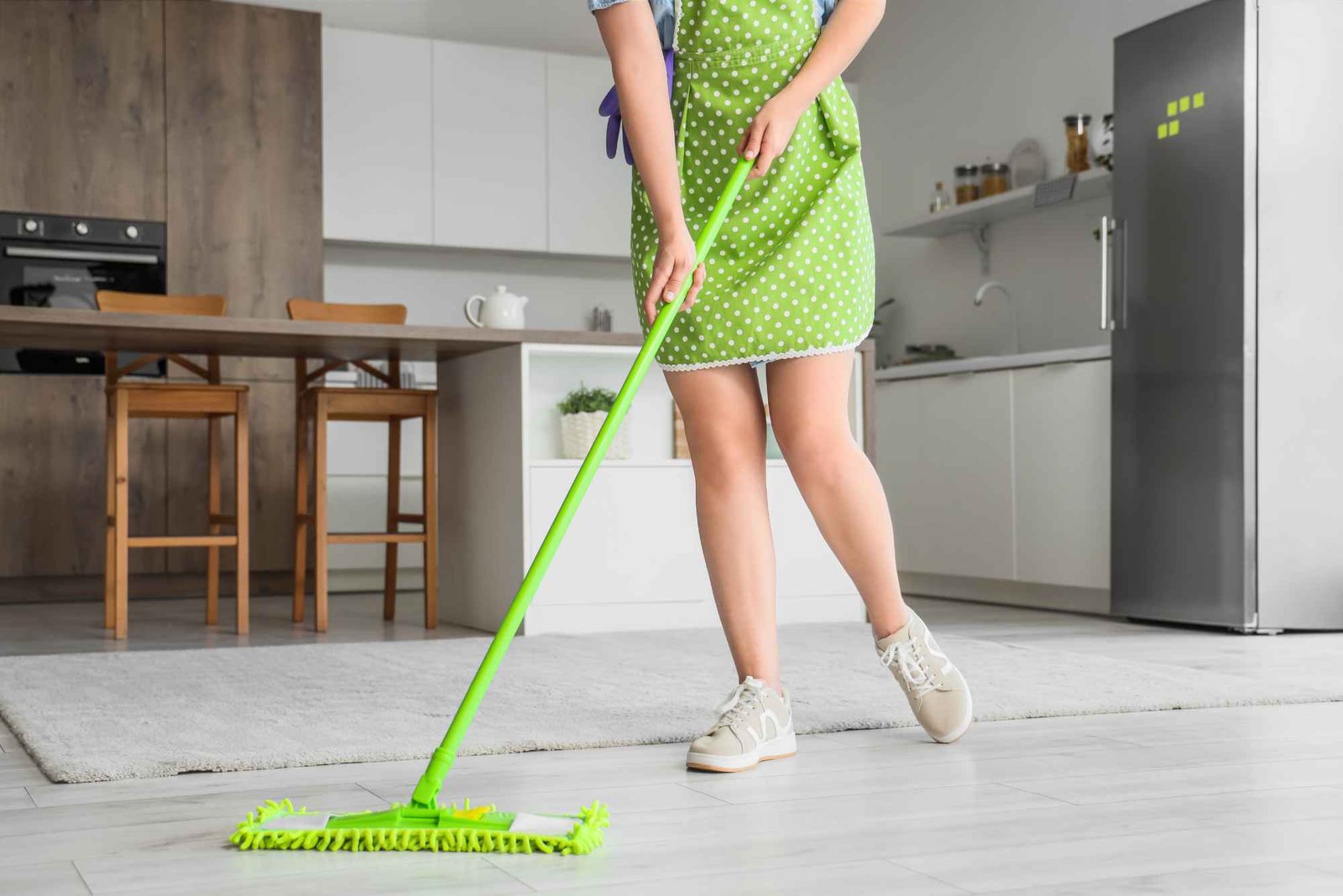There’s nothing more frustrating than muddy footprints across your carefully cleaned living room. When you mop the right way, each floor surface, from timeless timber to modern concrete, can remain pristine without damage.
Whether you have hardwood, tile, laminate, vinyl, or concrete floors, knowing the correct technique and cleaner is crucial.
This guide will discuss the best methods for each floor type and when expert assistance might be the best course of action.
Choose the Right Tools and Cleaners
Before you start, gather your supplies and make sure to always use clean water so as not to redistribute grime.
A microfibre mop is ideal. It’s gentle on surfaces, highly absorbent, and traps dust and dirt effectively. For deeper cleans, keep a bucket, soft scrub brush, and non-abrasive cloths on hand.
Select your cleaning solution based on the type of floor. For most floors, avoid anything highly acidic or bleach-based unless the manufacturer explicitly recommends it. Using a cleaner that’s too harsh can damage finishes, especially on timber, vinyl, and laminate.
If you’re ever unsure about floor cleaning methods, consider speaking with a professional cleaning service. They can recommend safe, effective products tailored to your floor type and even carry out a deep clean when needed.
Hardwood Floors: Gentle Care for a Lasting Finish
Hardwood flooring adds warmth and character, but it’s sensitive to moisture. Begin by sweeping or vacuuming with a soft brush attachment to remove dust and grit that could scratch the surface.
Skipping this step increases the risk of fine surface damage, especially in high-traffic areas like hallways.
Mop using a barely damp microfibre cloth, and never soak the surface. Use a pH-balanced wood floor cleaner, applying it sparingly to avoid build-up. Mop with the grain of the wood to reduce streaking and ensure consistent results.
Avoid all-purpose or strong detergents, as they often strip away protective finishes. Some waxed or oiled floors require specific products to maintain their seal.
Tile Floors: Deep Cleaning with Attention to Detail
Tiles are hard-wearing and popular in kitchens and bathrooms, but their grout lines attract grime. Start by sweeping to remove dry debris. Grit on the surface can cause minor scratches during mopping.
A steam mop is effective for sanitising without chemicals, particularly on ceramic or porcelain tiles. For weekly cleans, pair a microfibre mop with a mild detergent. When tackling the grout, use a soft-bristled brush and a grout-safe solution to avoid discolouration.
Start mopping from the furthest corner of the room, working your way towards the door to avoid walking over freshly cleaned areas. Rinse the mop frequently to prevent dirty water from dulling the surface.
Laminate Flooring: Light, Precise Maintenance
Laminate floors mimic wood at a fraction of the price, but they’re far less tolerant to moisture. To protect the surface, avoid wet mops or steam cleaners entirely. Even a little excess water can seep between boards and cause swelling.
Start with a dry dust mop or vacuum (use the hard floor setting) to remove particles. Then, use a barely damp mop and a laminate-specific cleaner. Always mop in straight lines, never circular motions, to prevent water pooling along the seams.
Be sure not to over-apply the cleaner. It’s tempting to spray more to remove a stain, but too much product can leave a residue. For spills, clean immediately with a dry cloth or a spritz of laminate cleaner.
Vinyl Floors: Durable Yet Delicate Cleaning
Vinyl is popular in UK kitchens and bathrooms thanks to its affordability and water resistance. While tough, it’s not invincible. Still, abrasive scrubbers and harsh chemicals can wear down the surface.
To keep vinyl in good condition, sweep regularly and mop weekly using a soft microfibre head. Choose a gentle vinyl-friendly detergent, and avoid anything containing ammonia. Mop in light circular motions to lift dirt and bring back shine. Rinse well to prevent streaks or sticky residue.
Also consider asking your cleaning provider about protective treatments. Some vinyl floors benefit from a polish coat that helps resist daily wear and tear.
Concrete Floors: Tough Surfaces, Smart Cleaning
Concrete is increasingly found indoors as a modern, minimalist choice. In garages, it’s often left unsealed, but inside, it may be polished or stained for a smoother finish. Either way, cleaning requires attention to detail.
Begin by sweeping or vacuuming thoroughly. Mop small areas using a neutral-pH concrete cleaner, as acidic products can etch the surface. Scrub stubborn stains immediately before they dry, and rinse the mop frequently.
For polished or sealed floors, dry mopping followed by damp mopping is usually enough. Once or twice a year, reapply sealant to protect against spills and surface wear.
General Mopping Tips to Keep in Mind
No matter the floor type, there are a few key principles to keep in mind:
- Change mop water frequently to avoid redistributing dirt.
- Sweep or vacuum first to remove abrasive grit.
- Stick to a schedule—regular mopping prevents the build-up of grime.
- Always use the right cleaner for your floor material.
- Ventilate the room while mopping to help floors dry faster and prevent streaking.
When to Consider a Professional Cleaning Service
There are moments when routine mopping isn’t quite enough, such as grime in grout, stubborn scuffs on laminate, and dull finishes on hardwood. In these cases, expert help saves time and protects your floors from further damage.
Professional cleaners don’t just scrub harder. They use targeted, approved products and equipment for each floor type. From steam treatments on tiles to buffing hardwood or sealing concrete, their work can add years to the life of your flooring.
You can also request a regular floor maintenance plan, ensuring your floors always look presentable without last-minute panics. It’s particularly helpful for homes with pets, children, or frequent visitors.
Conclusion
Caring for your floors doesn’t need to be complicated, but it does need to be done right.
Whether it’s polished timber, modern vinyl, or rustic concrete, the correct mopping method preserves their appearance and extends their life.
If you follow these techniques—and call in a professional when needed—you’ll enjoy clean, long-lasting floors that enhance the comfort and value of your home.







